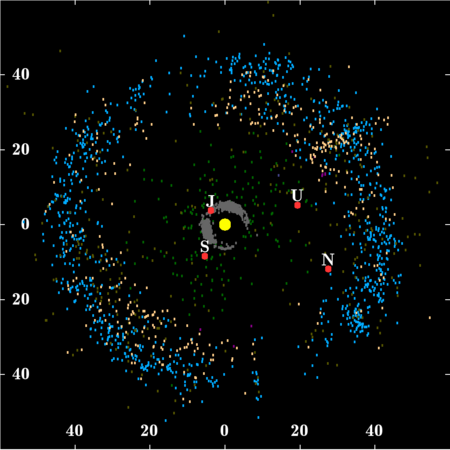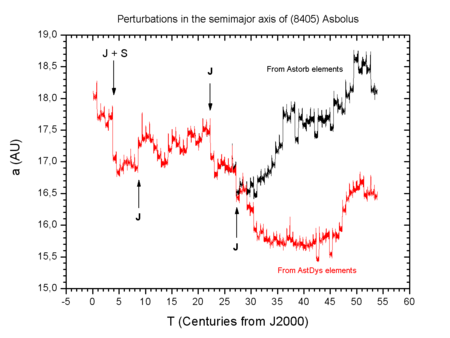Centaur (small Solar System body) facts for kids
A centaur is a special type of small space object. It orbits the Sun between the giant planets Jupiter and Neptune. Think of them as cosmic travelers that cross the paths of these huge planets.

| Sun Jupiter trojans (6,178) Scattered disc (>300) Neptune trojans (9) |
Giant planets: Jupiter (J) · Saturn (S) · Uranus (U) · Neptune (N) Centaurs (44,000) Kuiper belt (>100,000) |
Centaurs usually have orbits that are not very stable. This is because they often get close to the giant planets. Their orbits typically last only a few million years. However, one centaur, 514107 Kaʻepaokaʻawela, has a stable orbit, even though it moves backward.
These objects are a bit like a mix of asteroids and comets. They are named after the mythological centaurs, which were half-human and half-horse creatures. Scientists think there could be anywhere from 44,000 to over 10 million centaurs larger than 1 kilometer across.
The first centaur discovered was 944 Hidalgo in 1920. But scientists didn't really see them as a special group until 2060 Chiron was found in 1977. The biggest centaur confirmed so far is 10199 Chariklo. It's about 260 kilometers wide, similar to a medium-sized asteroid. Chariklo is also special because it has its own system of rings. It was found in 1997.
No centaur has been photographed up close yet. But scientists believe Saturn's moon Phoebe might be a captured centaur. The Cassini spacecraft took pictures of Phoebe in 2004. The Hubble Space Telescope has also gathered some information about the surface of 8405 Asbolus.
Some centaurs act like comets. About 30 of them have shown a fuzzy cloud of dust and gas, called a coma. This cloud forms when ice on their surface turns into gas. Three of these, 2060 Chiron, 60558 Echeclus, and 29P/Schwassmann-Wachmann 1, show signs of this activity even far from the Sun. If a centaur gets close enough to the Sun, it is expected to become a comet.
Contents
What are Centaurs?
Centaurs are small bodies that orbit the Sun between Jupiter and Neptune. They are known for crossing the orbits of one or more of these giant planets. This crossing makes their orbits unstable over long periods.
Even centaurs that don't currently cross a planet's orbit will eventually do so. Their paths are constantly changing. Some astronomers define centaurs by their average distance from the Sun. Others include any body that comes close to the giant planets.
Different Ways to Classify Centaurs
Different space organizations have slightly different rules for calling an object a centaur:
- The Minor Planet Center (MPC) says a centaur's closest point to the Sun must be beyond Jupiter's orbit. Its average distance from the Sun must be less than Neptune's.
- The Jet Propulsion Laboratory (JPL) defines centaurs as having an average distance from the Sun between Jupiter and Neptune.
- The Deep Ecliptic Survey (DES) uses computer simulations. They classify objects as centaurs if their orbits will cross a planet's path within 10 million years. This means centaurs usually have short lives in their current orbits.
Some objects are hard to classify because they fit different definitions. For example, 944 Hidalgo is sometimes called an asteroid, sometimes a centaur, and sometimes a Jupiter-family comet. The International Astronomical Union (IAU) names these objects after mythical creatures that are hybrids or can change shape.
How Centaurs Orbit
The orbits of centaurs vary a lot. Some have very stretched-out orbits, like 5145 Pholus and 8405 Asbolus. Others have more circular orbits, like 10199 Chariklo.
A few centaurs have very unusual orbits:
- 1999 XS35 has a very stretched orbit. It goes from inside Earth's orbit to far beyond Neptune.
- 2007 TB434 has an almost perfectly circular orbit.
- 2001 XZ255 has a very flat orbit, close to the plane of the planets.
- 1449082004 YH has a very tilted orbit, almost straight up and down.
More than a dozen known centaurs orbit backward compared to most objects in the Solar System. Their orbits are highly tilted. Scientists once suggested that 17 of these backward-orbiting centaurs might have come from outside our Solar System.
Changing Orbits
Centaurs' orbits are unstable. They change a lot over millions of years. This is because they don't have special protections from the giant planets' gravity. Scientists believe centaurs are objects moving from the Kuiper belt to become short-period comets.
Objects from the Kuiper belt can be pushed by Neptune's gravity. They then become centaurs. Their orbits are chaotic, meaning they change quickly as they pass near the outer planets. Some centaurs will eventually get close to Jupiter. This can pull them into the inner Solar System. If they show comet-like activity, they might then be called comets.
Eventually, centaurs will either crash into the Sun or a planet. Or, they might be thrown out of the Solar System entirely. This often happens after a close encounter with Jupiter.
What Centaurs are Made Of
It's hard to see the surfaces of centaurs because they are so small and far away. But scientists can study their colors and how they reflect light. This gives clues about what they are made of.
Colors of Centaurs
Centaurs come in many different colors. This makes it hard to have one simple idea about their surfaces. Scientists measure their colors using different light filters (blue, green-yellow, red).
Centaurs seem to fall into two main color groups:
- Very red: Like 5145 Pholus.
- Blue or blue-grey: Like 2060 Chiron.
There are many ideas about why centaurs have different colors. One idea is that they come from different places or are made of different things. Another idea is that their color changes over time. This can happen from radiation from the Sun or from comet-like activity.
For example, the red color of Pholus might be from a layer of red organic material. Chiron, on the other hand, might have exposed ice due to its comet-like activity, making it look blue-grey.
What Their Light Shows
By looking at the light reflected from centaurs, scientists can guess what their surfaces are made of. It's not always clear, but it gives important clues.
Water ice has been found on several centaurs, including 2060 Chiron, 10199 Chariklo, and 5145 Pholus. Besides water ice, scientists think centaur surfaces might have:
- Chariklo: A mix of tholins (like those on Titan and Triton) and carbon.
- Pholus: A mix of Titan-like tholins, carbon black, olivine, and methanol ice.
- Okyrhoe: A mix of kerogens, olivines, and a little water ice.
- Asbolus: A mix of different types of tholins and amorphous carbon.
Chiron seems to be the most complex. Its light changes depending on when it's observed. Water ice was seen when it was quiet, but it disappeared when it was active.
Like Comets
In 1988 and 1989, Chiron showed a coma (a cloud of gas and dust). This happened when it was closest to the Sun. Because of this, Chiron is now officially called both a minor planet and a comet. It's much bigger than a typical comet, though.
Other centaurs are watched for comet-like activity. So far, 60558 Echeclus and 166P/NEAT have shown this behavior. 166P/NEAT was discovered with a coma, so it's classified as a comet, even though its orbit is like a centaur's. 60558 Echeclus was found without a coma but later became active. So, it's also now both a comet and an asteroid.
Scientists have found small amounts of carbon monoxide on 60558 Echeclus and Chiron. This gas is enough to explain the comas they show.
Size and Density
Centaurs can be hundreds of kilometers wide. The largest ones are over 300 kilometers across. Most of these bigger centaurs are found beyond 20 AU (AU is the distance from the Earth to the Sun).
Where Centaurs Come From
Scientists are still learning about where centaurs come from. There are a few ideas:
- From the Kuiper Belt: Simulations suggest that objects in the Kuiper belt can be pushed out of their orbits. This can happen when they get too close to Neptune. These objects then become centaurs.
- From Collisions: Some centaurs might have formed from pieces breaking off larger objects. This could happen during close encounters with giant planets like Jupiter.
- From Saturn's Moons: One centaur, 2013 VZ70, might have come from Saturn's irregular moons. This could happen if a moon was hit, broke apart, or was pulled apart by Saturn's gravity.
Scientists hope to learn more as they gather more information about objects in the Kuiper belt.
Famous Centaurs
Here are some well-known centaurs:
| Name | Year Discovered | Discoverer | How long their orbit lasts (Ma = Million years) | Class |
|---|---|---|---|---|
| 55576 Amycus | 2002 | NEAT | 11.1 Ma | Uranus-crossing |
| 54598 Bienor | 2000 | Marc W. Buie et al. | ? | Uranus-crossing |
| 10370 Hylonome | 1995 | Mauna Kea Observatory | 6.3 Ma | Uranus-Neptune-crossing |
| 10199 Chariklo | 1997 | Spacewatch | 10.3 Ma | Uranus-crossing |
| 8405 Asbolus | 1995 | Spacewatch (James V. Scotti) | 0.86 Ma | Saturn-Neptune-crossing |
| 7066 Nessus | 1993 | Spacewatch (David L. Rabinowitz) | 4.9 Ma | Saturn-Kuiper-crossing |
| 5145 Pholus | 1992 | Spacewatch (David L. Rabinowitz) | 1.28 Ma | Saturn-Neptune-crossing |
| 2060 Chiron | 1977 | Charles T. Kowal | 1.03 Ma | Saturn-Uranus-crossing |
See also
 In Spanish: Centauro (astronomía) para niños
In Spanish: Centauro (astronomía) para niños




